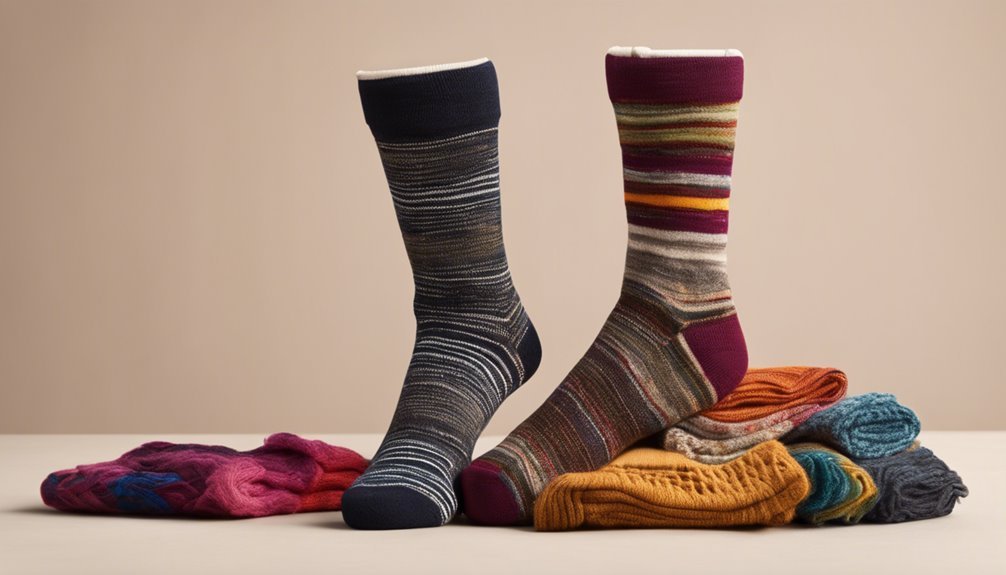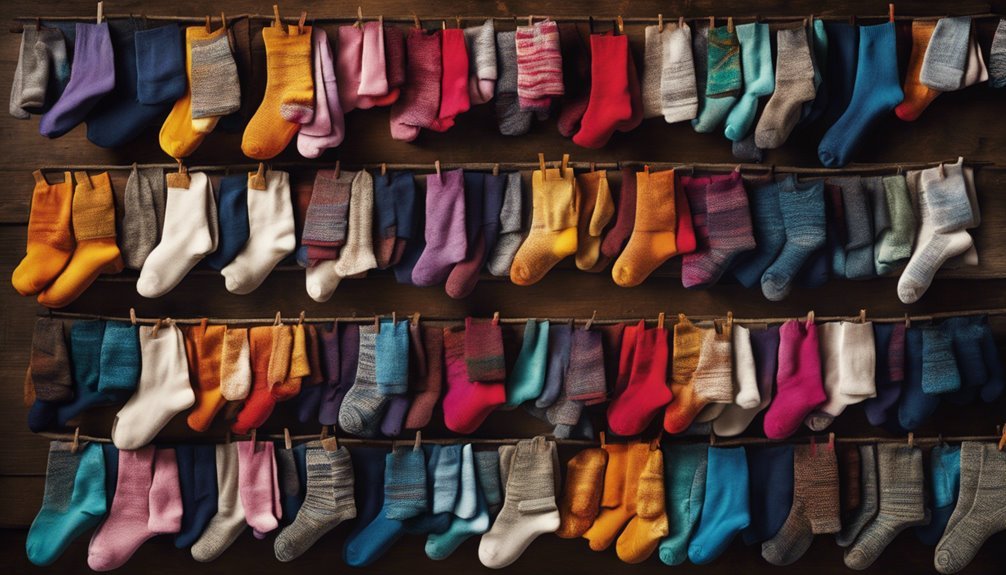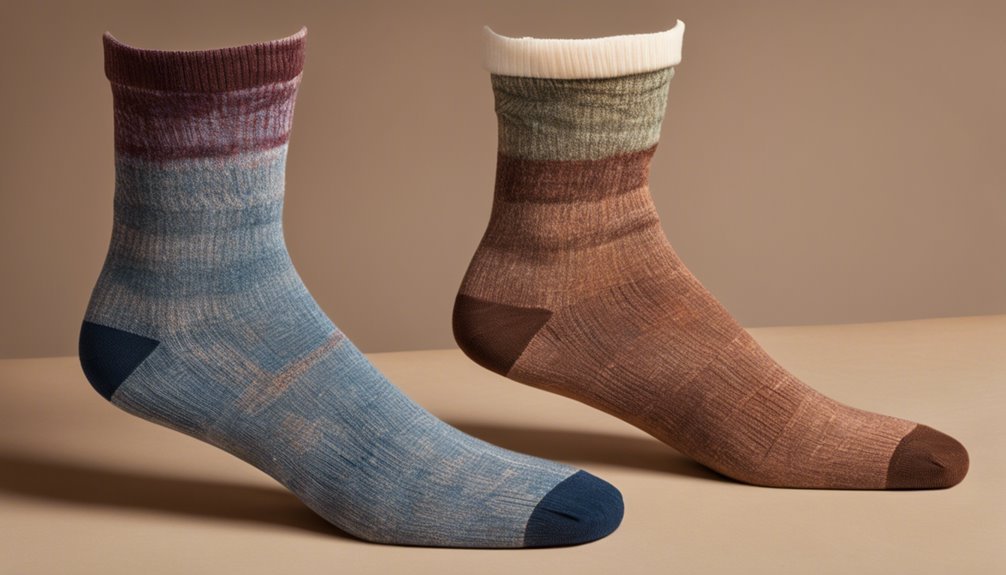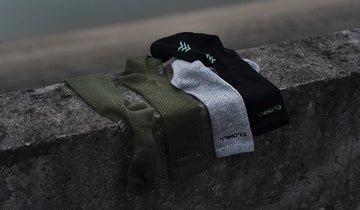Mass-Produced Socks vs. Handcrafted Socks: Which Lasts Longer?
Mass-produced socks usually wear out faster than handcrafted options due to their reliance on synthetic materials and automated production methods. The quality of materials and stitching in handcrafted socks, often made from natural fibers, enhances durability and comfort over time. While mass-produced variants may be more affordable initially, they often require frequent replacements, undermining their long-term value. If you consider all factors, you'll see considerable differences that could impact your choice considerably.
Understanding Mass-Produced Socks: Materials and Construction

When you consider mass-produced socks, it's essential to understand the materials and construction methods involved, as these factors directly influence durability and comfort. Mass-produced socks typically utilize synthetic fiber types, such as polyester and nylon, due to their cost-effectiveness and strength. These fibers enhance moisture-wicking capabilities, prolonging wear. The production techniques employed often involve automated knitting machines that guarantee uniformity and efficiency but may sacrifice individual quality control. Seamless designs can minimize friction, yet the standardization may lead to less adaptability in fit. Understanding these elements allows you to assess how well these socks meet your needs, balancing budget constraints with the desire for reliable, durable footwear that supports your freedom of movement.
The Allure of Handcrafted Socks: Quality and Artistry
Handcrafted socks embody a unique blend of quality and artistry that mass production often overlooks. By utilizing artisanal techniques, these socks present not only functionality but also a personal touch. When you choose handcrafted socks, you're embracing:
- Unique designs that express individuality.
- Superior materials that enhance comfort and durability.
- Expert craftsmanship that guarantees precise fit.
- A sustainable approach that values ethical production.
Each pair showcases the artisan's skill, resulting in a product that stands apart from generic alternatives. You're not just wearing socks; you're making a statement about quality and creativity. Handcrafted socks invite you to appreciate the meticulous effort behind each stitch, offering a tangible connection to the artistry that mass-produced items simply can't replicate.
Comparing Durability: Testing the Lifespan of Both Types
The distinction between handcrafted and mass-produced socks extends beyond aesthetics and craftsmanship; it greatly impacts durability and lifespan. To truly understand the differences, you should engage in durability testing of both types. Mass-produced socks often utilize synthetic materials that may initially appear robust but tend to wear out quickly under consistent use. In contrast, handcrafted socks typically feature natural fibers, offering superior resilience and longevity. When you conduct a lifespan comparison, focus on factors like material quality, stitching techniques, and wear patterns. Observing how each sock type performs under various conditions will reveal the true implications for everyday wear. Ultimately, your choice may hinge on the balance between immediate convenience and lasting durability.
Cost-Effectiveness: Long-Term Value of Your Sock Investment

While many consumers focus on the initial purchase price, it's crucial to take into account the long-term value of your sock investment. A thorough cost analysis reveals that mass-produced and handcrafted socks differ markedly in investment longevity. Here are four factors to evaluate:
- Durability: Handcrafted socks generally endure wear and tear longer.
- Replacement Frequency: Mass-produced socks often require more frequent replacements, increasing overall costs.
- Comfort and Performance: Higher-quality materials in handcrafted socks can enhance comfort, leading to better usage over time.
- Sustainability: Investing in handcrafted options supports ethical practices, reducing environmental costs.
Ultimately, weighing these elements can guide you toward a more informed decision, ensuring your sock investment pays off in the long run.
Personal Preferences: Choosing the Right Sock for You
How do you determine which socks best suit your lifestyle and preferences? Start by evaluating your daily activities; different sock styles cater to varying needs. For athletic pursuits, moisture-wicking fabrics enhance performance, while cushioned options provide comfort for long hours of wear. Consider your fabric preferences—cotton offers breathability, while merino wool provides temperature regulation and odor resistance.
Additionally, think about the aesthetic appeal; patterns and colors can express your personal style. If sustainability is essential to you, look for eco-friendly options in both mass-produced and handcrafted socks. Ultimately, aligning your sock choices with your lifestyle guarantees you enjoy both comfort and durability, empowering you to move freely throughout your day.
Frequently Asked Questions
Can Mass-Produced Socks Be Environmentally Friendly?
Think of mass-produced socks as a double-edged sword; they can be environmentally friendly if crafted from sustainable materials and use eco-conscious production processes. The balance between convenience and sustainability is essential for your choices.
Do Handcrafted Socks Offer Custom Sizing Options?
Handcrafted socks do indeed offer custom sizing options, ensuring a perfect custom fit. You'll also enjoy unique designs tailored to your preferences, enhancing both comfort and style while allowing for greater freedom of expression in your wardrobe.
How Do Washing Methods Affect Sock Longevity?
You wouldn't believe how washing temperature and drying methods can wreak havoc on your socks! Hot washes and high heat can cause fibers to fray, drastically shortening their lifespan. Care matters if you want longevity!
Are There Specific Brands Known for Durable Mass-Produced Socks?
When considering durable mass-produced socks, you'll find brands like Darn Tough and Smartwool stand out. Their use of durable materials guarantees longevity, making brand comparisons essential for quality and cost-effectiveness in your sock selection.
What Is the Lifespan of Socks With Daily Wear?
Daily wear typically results in a sock lifespan of 6 to 12 months, depending on sock materials and individual wear patterns. Factors like fabric type and usage frequency greatly influence durability and overall performance over time.







